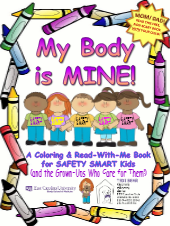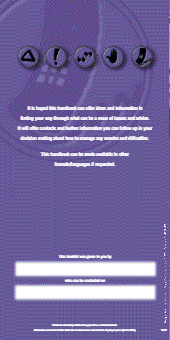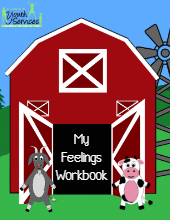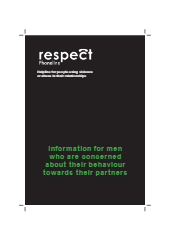The Kids Central Toolkit aims to provide workers and services with information, resources and tools to use child-centred approaches in their work with children, young people and families. The Toolkit is based around six key principles that support child-centred practice, and each principle includes a range of tools and resources, which are available to download:
Principle 1: Keep Me Safe
Children and young people’s safety and wellbeing are of primary importance.
Tools
 Tool 1A: Identifying Risks (PDF, 301KB)
Tool 1A: Identifying Risks (PDF, 301KB)
Can be used to begin a discussion about safety; help families develop strategies and to plan ways of responding to any risks they might face; and help children develop a sense of safety in the knowledge that their concerns have been raised and dealt with.
Tool 1B: Safety Plan (PDF, 369KB)
Can be used to help families develop a plan for when they are confronted by potential threats to their safety.
Tool 1C: How I’m Feeling (PDF 3.10MB)
Can be used to hear from children about how they are feeling and to give children permission to talk about or express their feelings in a safe and non-threatening way
Tool 1D: Things That Make Me Feel Safe (PDF, 302KB)
Can be used to introduce the topic of safety to children; hear from children about the things that help them feel safe; help with safety planning for individual children; and help families understand what each child needs to feel safe.
Tool 1E: Worryometer (PDF, 284KB)
Can be used to get a sense of how unsafe or worried children are feeling; allow exploration of what is making children feel unsafe, what helps them feel safer and less safe; and help children begin to differentiate between big worries and little worries.
Tool 1F: Helping Hands (PDF 298, KB)
Can be used to find out who children can trust in their networks; to see how small or large a child’s safety network is; and helps with making safety plans, to fill in safety cards for each family member.
Tool 1G: Responding to Concerns (PDF, 261KB)
Can be used to respond to children’s safety issues and concerns that might arise in discussions / planning.
Tool 1H: Safe Spaces (PDF, 477KB)
Can be used to help kids develop skills in relaxing and conclude a group session.
Tool 1I: Jumping Jellyfish (PDF 400KB)
Can be used to explore safety and trust in a fun way; allow children to experiment with trusting someone else in a safe environment; help workers and parents gain understanding of a child’s sense of safety and ability to trust. Also affords a great opportunity to talk about feelings, how we know when we feel safe, how we know if we feel unsafe, listening to our body’s messages and our feelings.
Booklet: Keep Me Safe
This booklet provides information on talking about tough stuff with kids and parents; what to do when a kid discloses abuse, harm or fear of harm; creating a kid-safe service; planning for safety; power and children’s safety; tools and activities for kids about safety; a scenario and links to other resources.
Booklet: Keep Me Safe (PDF, 5.4MB)
Poster: Keep Me Safe (PDF, 581KB)
Principle 2: I’m One of a Kind
Children are individuals with unique needs and wishes. They have entitlements to a voice of their own and have intrinsic value in themselves as well as in being members of families.
 Tools
Tools
Tool 2A: The Name Game (PDF, 193KB)
Can be used as a warm up game when beginning group activities, to build rapport and help children feel comfortable.
Tool 2B: I’m a Star (PDF, 247KB)
Can be used to find out about individual children’s needs and wishes, build rapport and identify strengths.
Tool 2C: It’s All About Me (PDF, 228KB)
Can be used to find out about how children see themselves, their talents and gifts.
Tool 2D: What I’d Like (PDF, 223KB)
Can be used to find out about the things children are feeling and thinking about their current and future situations, and what they would like to see happen for them and their families.
Tool 2E: Here and There (PDF, 213KB)
Can be used to find out about the things children are wanting and to identify how they might be effected.
Tool 2F: Eye See You (PDF, 183KB)
Can be used to help adults give kids positive affirmations, help kids feel good about themselves, help adults connect with kids, and help boost self-esteem.
Tool 2G: Catching Dreams (PDF, 155KB)
Can be used to give children an opportunity to talk about their hopes and dreams, and build rapport.
Booklet: I’m One of a Kind
This booklet provides ideas about why it’s important to see each child as unique and special; websites on child development; ideas about how to explore children’s needs and wishes; thoughts about culture and working with families from Aboriginal and Torres Strait Islander and other culturally diverse backgrounds; and information on child-centred, family-focused assessment.
Booklet: I’m One of a Kind (PDF, 2.3MB)
Poster: I’m One of a Kind (PDF, 588KB)
Principle 3: My Family is Special
Children are usually best supported within their families. Respectful connections with families foster partnerships to promote children’s safety.
 Tools
Tools
Tool 3A: Our Strengths (PDF, 233KB)
Can be used to help families identify and celebrate strengths, plan ways to build on their strengths, and get a sense of hope and change for the future.
Tool 3B: All Tied Up (PDF, 190KB)
Can be used to help families identify their strengths and how they rely on each other, help children realise they have positive people around them, and also that they are not the only support people available to their parents / family members; identify additional supports and affirm family relationships and connections.
Tool 3C: Common Ground (PDF, 197KB)
Can be used to highlight family strengths that can be built upon or used to help families plan, and to gain insights into family dynamics, relationships and roles.
Tool 3D: Sentence Stems (PDF, 206KB)
Can be used to assist families with a way to talk about a range of experiences, including difficult ones; and provide an opportunity for families to listen to each others perspectives on their needs, problems, strengths and hopes.
Tool 3E: My Family Collage (PDF, 192KB)
Can be used to help families create a positive picture of their family, see what they have in common, and define what they value, what is important to them, and how they want to be as a family.
Tool 3F: Family Portraits (PDF, 208KB)
Can be used to start discussions about family and family strengths, and learn more about children’s support networks.
Tool 3G: Family Coat of Arms (PDF, 216KB)
Can be used to help families understand each others needs and experiences of being in the family, think through how to meet the needs of different family members, particularly children; draw out common positive experiences and identify simple things that can be done to enhance everyone’s happiness and wellbeing.
Tool 3H: Giant Puzzle (PDF, 187KB)
Can be used to help families identify the needs of each individual and help families affirm their relationships and connections.
Tool 3I: How Are We Going? (PDF, 206KB)
Designed to be used with families in an open way so that they understand your concerns and you understand theirs.
Booklet: My Family is Special
This booklet provides information and tips for seeing each family as unique and special; recognising and building on strengths, skills and capabilities of children and their families; support for parents; family relationships; identifying and working with family issues; relationship-based assessments; skills and tools for working with families; a case scenario and pulse check.
Booklet: My Family is Special (PDF, 2.3MB)
Poster: My Family is Special (PDF, 277KB)
Principle 4: Make It Fun
Environments surrounding children are child-friendly and provide them with opportunities to develop and grow.
 Tools
Tools
Tool 4A: Memory Boxes (PDF, 179KB)
Can be used to help children collect memorabilia.
Tool 4B: Gratitude Journals (PDF, 163KB)
Can be used to help children recognise that some of the good things in life are outside of themselves, and to affirm positive things in the life of the child.
Tool 4C: Friendly Maps (PDF, 176KB)
Can be used to gauge how child-friendly your space is, get feedback from children about which spaces feel safe and which don’t, and get ideas on how to improve them.
Tool 4D: What I Can Expect and 4E: When I’m Not Happy (PDF, 218KB)
Can be used to help children understand the way that you have agreed to work with them and their families, allay children’s fears about your role, and provide children with a mechanism to air their concerns or complaints.
Tool 4F: Funny Faces (PDF, 186KB)
Just for fun!
Booklet: Make It Fun
This booklet provides information about what children say they need most, helping children gain ownership over space, creating child-friendly spaces, taking child-friendly environments with you, why play is so important, and games.
Booklet: Make It Fun (PDF, 2.2MB)
Poster: Make It Fun (PDF, 585KB)
Principle 5: Keep Me in the Loop
Children are provided with information and given opportunities to participate in decision-making processes that affect their lives.
 Tools
Tools
Tool 5A: Talking Cards (PDF, 261KB)
Can be used to break the ice and build rapport, to break up discussions, and to get conversations started.
Tool 5B: Clay Faces (PDF, 210KB)
Can be used to help children talk about their feelings in a non-threatening and child-directed way.
Tool 5C: What I Want (PDF, 227KB)
Can be used to develop a quick understanding of a child’s immediate needs, and to invite children into a conversation about their needs and wishes.
Tool 5D: Responding to Kids’ Requests (PDF, 276KB)
Can be used to ensure children understand you are taking their needs and wishes seriously.
Tool 5E: Wanted Posters (PDF, 220KB)
Can be used to talk to children about the kinds of workers they want and how they want to be supported.
Tool 5F: Rights and Not-Quite Rights (PDF, 291KB)
Can be used to help kids understanding what their rights are in relation to talking to adults.
Tool 5H-L: On Target (PDF, 468KB)
Can be used to help children and families articulate their feelings, track their progress and plan for the future.
Booklet: Keep Me in the Loop
This booklet provides information and tips about keeping children informed about what is going on, why it’s important to see, hear and act upon what kids have to say, and resources and tools for communicating with children.
Booklet: Keep Me in the Loop (PDF, 3.4MB)
Poster: Keep Me in the Loop (PDF, 564KB)
Principle 6: Who Else Matters?
Children and families live in communities with strengths and resources. The best outcomes are often achieved in partnership with other who can assist children and families in an ongoing way.
 Tools
Tools
Tool 6A: People in Our Lives and 6B: People in My Life (PDF, 273KB)
Can be used to help identify important others in the lives of children and families, and to identify resources and supports.
Tool 6C: Helping Hands (PDF, 230KB)
Can be used to help children identify important people and supports in their lives, celebrate their connections to others, and help workers find formal and informal supports for families over time.
Tool 6D: My Supporters (PDF, 252KB)
Can be used to help children identify support people and recognise they are not alone.
Tool 6E: It Takes a Village (PDF, 250KB)
Can be used to help identify community resources, and the supporters that children might be connected to as part of their case work.
Tool 6F: Sharing My Story (PDF, 230KB)
Can be used to reach an agreement with children about what they are happy for workers to share with their parents, other family members and workers.
Tool 6G: Holding It Together (PDF, 209KB)
Can be used to help plan ongoing support for children and families, alleviate children’s fear about losing support after exiting a program, and to identify alternative options.
Tool 6H: Mapping the Service System (PDF, 165KB)
Can be used to develop a better understanding of the services and supports available to children and families in their local area.
Booklet: Who Else Matters?
This booklet provides information on what children say they need from services working together to support them, tips on connecting children to their natural networks, and tools and resources for making service partnerships work.
Booklet: Who Else Matters? (PDF, 2.9MB)
Poster: Who Else Matters? (PDF, 583KB)
Booklet for Children: All About Me (PDF, 4.3MB)
This assessment booklet for children provides a way for them to record their thoughts and ideas, and share these with their worker. It includes an agreement whereby children can specify what they are comfortable with their worker sharing with others.








